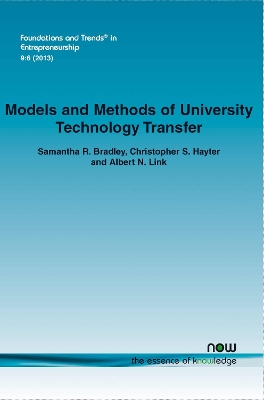Foundations and Trends (R) in Entrepreneurship
3 total works
Models and Methods of University Technology Transfer
by Samantha R. Bradley, Christopher S. Hayter, and Albert N. Link
Published 24 May 2013
Models and Methods of University Technology Transfer covers the rise of university technology transfer since the 1980's, as well as the economic and academic benefits that stem from the commercialization of university-discovered technologies. Currently, most literature on university technology transfer focuses on institutions that facilitate commercialization, and models that oversimplify the technology transfer process by assuming that the knowledge flow is linear.
The book reviews existing literature regarding university technology transfer in terms of the process within the traditional linear model. After an address of the limitations of the traditional model, alternatives conceptualizations of technology transfer are presented in order to more accurately illustrate university technology transfer in practice.
The book reviews existing literature regarding university technology transfer in terms of the process within the traditional linear model. After an address of the limitations of the traditional model, alternatives conceptualizations of technology transfer are presented in order to more accurately illustrate university technology transfer in practice.
Capturing Knowledge explores the Extent to which knowledge transferred from a university to a firm or group of firms through a research partnership results in short-term private gains to a firm as well as to long-term public gains to society. It is descriptive in nature with the goal to appeal not only to academic researchers but also to reach students and learned individuals. Following a brief review of the extant academic literature Section 2, Section 3 summarizes the Small Business Innovation Act of 1982, which created the U.S. Small Business Innovation (SBIR) program. Descriptive information about universities as research partners in SBIR projects is presented in Section 4. The descriptive empirical analyses presented in Section 5 focus on the impact of university research partnerships on the performance of SBIR-funded projects and firms. They emphasize the private gains to the firm from its research involvement with a university and explore the presence of public gains. Concluding remarks are offered in Section 6.
This monograph defines public sector entrepreneurship in terms of innovative public policy initiatives that generate greater economic prosperity by transforming a status quo economic environment into one that is more conducive to economic units engaging in creative activities in the face of uncertainty. Based on that definition, the author examines Vannevar Bush as an example of a public sector entrepreneur. Using Bush and the Bayh-Dole Act of 1980 as an example of public sector entrepreneurship, the monograph provides a framework that can serve as a unifying taxonomy for interpreting future research on public sector entrepreneurship.


